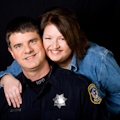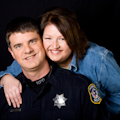The term front-line leadership is one it seems we’ve been hearing rather frequently of late (as well as its close semantic cousin leading from the front) but whose definition is somewhat elusive. That elusiveness may have to do with both terms tendency to create different representations to different users, and in the context of different leadership circumstances. Both terms have been used frequently in the realms of politics, business, and public service, and I’m sure they conjure different images in each.
In the trainings we do, especially Police Morale For Supervisors: It IS Your Problem!, and occasionally our writing, we’ve used both terms somewhat interchangeably and while referencing various illustrations in a way we think makes sense to our audience. It occurred to us, though, that the term might still be a little ambiguous, or that what we mean when we talk about it might not translate in the mind of someone listening to or reading our words. We thought it might be interesting to try and define the term as we understand and intend it, and then propose how “leading from the front” in that context offers powerful benefits to law enforcement.
“There’s fire along that hedgerow there. Take care of it”
First Lieutenant Richard “Dick” Winters was 26 years old on June 6, 1944 and, despite having served nearly three years in the Army while World War II raged, had yet to lay eyes on the enemy or fire a shot in anger. His combat debut was about to make history.
He started the day and made his jump at Normandy as the Executive Officer of Easy Company, 2nd Battalion, 506th Parachute Infantry Regiment of the 101st Airborne Division. He found himself thrust into command when the C-47 transport plane carrying the unit’s Commanding Officer, Thomas Meehan III, was torn from the sky by German anti-aircraft fire, killing all aboard. After locating and linking up with his unit, Winters was ordered to the front where he was tersely given his first assignment: “There’s fire along that hedgerow there. Take care of it.”
And that was the extent of his orders and information!
About three miles south of Utah Beach lay Brécourt Manor, where four 105 mm German Howitzers were placed, connected by a series of trenches, and defended by approximately 60 German infantry troops. The guns had been disrupting landing operations on Utah Beach by firing onto a causeway leading away from the landing zone; in order to clear the beach and safely make their way inland, Allied troops needed the guns neutralized. Several other Allied units had come across the artillery that morning but their efforts to attack it were rebuffed by its defenders.
After a brief recon of his objective, Winters gathered 26 soldiers, 13 from his own Easy Co and 10 from Dog Co, and with virtually no information about their target or what else they might encounter on the other side of the distant hedgerow it lay behind, they set off to destroy it. Reaching the artillery battery, Winters made his plan.
After setting up two .30 caliber machine guns to provide cover fire, he dispatched a small team of soldiers to flank and destroy one of the machine gun positions defending the heavy artillery and then set up additional cover fire from their new position. Winters then led his team into the German’s own trenches, figuring them to provide additional cover they wouldn’t have otherwise had attacking exposed over the surface, and attacked each of the heavy artillery in turn, destroying each by first killing or driving off the Germans manning and defending them and then shoving TNT down their barrels and detonating it with captured German grenades. The fourth Howitzer was taken out by a contingent commanded by Dog Company’s 2nd Lt Ronald Speirs, who led his men in a daring open field attack to get to and destroy the gun.
After wiping out the four heavy guns that had been hindering the Allied advancement from Utah Beach, Winters and company came under heavy machine gun fire from Brécourt Manor and, having succeeded in their objective, withdrew back to their own lines. But they returned with a bonus prize! In one of the gun positions a German map of all the artillery and machine gun locations on the Cotentin Peninsula was found. He presented the map to Intelligence Officer (and Winters’ closest friend) 1st Lieutenant Lewis Nixon, who recognized its value and personally delivered it to the command staff on Utah Beach. This would prove an invaluable source of information to the Allies and hasten their success on D-Day.
-----------------
We often look to the actions and decisions of Lt (later Major) Dick Winters as prime examples of what we consider front-line leadership when we use them as examples in our classes and writing, both at Brécourt Manor and beyond. The exploits of Easy Company in World War II are legendary, from D-Day to Operation Market Garden and the Battle of the Bulge, through the capture of Berchtesgaden, and a study of their history becomes a study of the front-line leadership of Richard Winters… and the front-line leadership he inspired in those under his command.
Dick Winters was a soldier. College educated and a businessman at heart, he was certainly not a career Army man by any stretch. In fact, he was offered a regular commission after the war but declined it to take a job with Lewis Nixon’s family business. Nonetheless, he was a soldier. More importantly, he was a leader. He inspired others to move forward into danger and uncertainty by being willing to move first. He truly led from the front, seeing himself not as a commissioned officer to hang back while sending others into harm’s way but as one responsible to step first into harm’s way. He recognized what was his duty – the need of the moment and his obligation to the meet it – and stepped up to meet it. He didn’t hesitate to send others into difficult assignments, or to delegate tough responsibilities, nor was he afraid to lead by example by confronting personal danger and difficult responsibility head-on himself. Some of his men even expressed wonder, decades after the war’s end, that he even survived because of his willingness to lead from the front where the bullets flew.
By the end of the war, a number of Easy Company had suffered wounds in battle. Many could have chosen lighter duty for the duration of the war because of them – or even been discharged to legitimate “Hometown Hero” status to ride out the rest of the war – but chose to return to the brotherhood of heroes in Easy Company though it meant driving deeper into Germany and facing danger once again. Leaders were developed from the example of Easy Company’s command.
So how does this translate to law enforcement? How do the exploits of a small group of soldiers scratching their way from the beaches of France to the German Alps relate to what we do every day? The day-to-day experiences, unless you are in one of the toughest and most dangerous beats in America, may not remotely match at first glance. But the leadership attitudes behind those exploits – the attitudes and sense of duty behind those exploits - certainly can. Next month we will look at some ways those very attitudes and sense of duty directly relate to our experience as law enforcement officers.
For more information on Major Dick Winters and Easy Company be sure to check out these resources:
Band of Brothers: E Company, 506th Regiment, 101st Airborne from Normandy to Hitler's Eagle's Nest by Stephen Ambrose
Band of BrothersStarring Damian Lewis, Ron Livingston, Donnie Wahlberg, et al. (Nov 5, 2002) DVD
Web Links:
- Follow Mike & Althea on Facebook
- Check out their upcoming training calendar
- More Than A Cop online
- Brecourt Manor Assault
About The Authors:
Althea Olson, LCSW and Mike Wasilewski, MSW have been married since 1994. Mike works full-time as a police officer for a large suburban Chicago agency while Althea is a social worker in private practice in Joliet & Naperville, IL. They have been popular contributors of Officer.com since 2007 writing on a wide range of topics to include officer wellness, relationships, mental health, morale, and ethics. Their writing led to them developing More Than A Cop, and traveling the country as trainers teaching “survival skills off the street.” They can be contacted at [email protected] and can be followed on Facebook or Twitter at More Than A Cop, or check out their website www.MoreThanACop.com.
About the Author

Michael Wasilewski
Althea Olson, LCSW and Mike Wasilewski, MSW have been married since 1994. Mike works full-time as a police officer for a large suburban Chicago agency while Althea is a social worker in private practice in Joliet & Naperville, IL. They have been popular contributors of Officer.com since 2007 writing on a wide range of topics to include officer wellness, relationships, mental health, morale, and ethics. Their writing led to them developing More Than A Cop, and traveling the country as trainers teaching “survival skills off the street.” They can be contacted at [email protected] and can be followed on Facebook or Twitter at More Than A Cop, or check out their website www.MoreThanACop.com.

Althea Olson
Althea Olson, LCSW and Mike Wasilewski, MSW have been married since 1994. Mike works full-time as a police officer for a large suburban Chicago agency while Althea is a social worker in private practice in Joliet & Naperville, IL. They have been popular contributors of Officer.com since 2007 writing on a wide range of topics to include officer wellness, relationships, mental health, morale, and ethics. Their writing led to them developing More Than A Cop, and traveling the country as trainers teaching “survival skills off the street.” They can be contacted at [email protected] and can be followed on Facebook or Twitter at More Than A Cop, or check out their website www.MoreThanACop.com.
